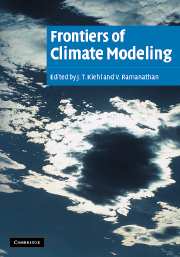Book contents
- Frontmatter
- Contents
- Preface
- List of Contributors
- Acknowledgments
- 1 Overview of climate modeling
- 2 Climate-change modeling: a brief history of the theory and recent twenty-first-century ensemble simulations
- 3 Energy-balance climate models
- 4 Intrinsic climatic variability: an essay on modes and mechanisms of oceanic and atmospheric fluid dynamics
- 5 The radiative forcing due to clouds and water vapor
- 6 A model study of the effect of Pinatubo volcanic aerosols on stratospheric temperatures
- 7 Unresolved issues in atmospheric solar absorption
- 8 Cloud feedbacks
- 9 Water-vapor feedback
- 10 Water-vapor observations
- 11 New frontiers in remote sensing of aerosols and their radiative forcing of climate
- 12 Cloud–climate feedback: lessons learned from two El Niño events
- 13 Runaway greenhouses and runaway glaciations: how stable is Earth's climate?
- Glossary
- Plate section
5 - The radiative forcing due to clouds and water vapor
Published online by Cambridge University Press: 12 August 2009
- Frontmatter
- Contents
- Preface
- List of Contributors
- Acknowledgments
- 1 Overview of climate modeling
- 2 Climate-change modeling: a brief history of the theory and recent twenty-first-century ensemble simulations
- 3 Energy-balance climate models
- 4 Intrinsic climatic variability: an essay on modes and mechanisms of oceanic and atmospheric fluid dynamics
- 5 The radiative forcing due to clouds and water vapor
- 6 A model study of the effect of Pinatubo volcanic aerosols on stratospheric temperatures
- 7 Unresolved issues in atmospheric solar absorption
- 8 Cloud feedbacks
- 9 Water-vapor feedback
- 10 Water-vapor observations
- 11 New frontiers in remote sensing of aerosols and their radiative forcing of climate
- 12 Cloud–climate feedback: lessons learned from two El Niño events
- 13 Runaway greenhouses and runaway glaciations: how stable is Earth's climate?
- Glossary
- Plate section
Summary
Introduction
As the previous chapters have noted, the climate system is forced by a number of factors, e.g., solar impact, the greenhouse effect, etc. For the greenhouse effect, clouds, water vapor, and CO2 are of the utmost importance. The emergence of computers as a viable scientific tool in the 1960s in conjunction with the availability of spectroscopic data enabled us to treat the numerous complexities of infrared-radiative transfer in the atmosphere. While such calculations set the stage for estimating accurately (decades later in the 1990s) the radiative forcing due to greenhouse gases and clouds, they did not yield the necessary insights into the physics of the problem nor did they yield any explanation of the relevant phenomenon. Such insights needed physically based analytic approaches to the problem. It is in this arena that Dr. Robert Cess excelled and provided the community with important insights into numerous radiative processes in the atmosphere of Earth and other planets including Mars, Venus, Jupiter, and Saturn. A few examples that are relevant to the main theme of this chapter are given below.
Within the lower atmosphere of many planets (first 10km of Earth; 5km for Mars; and 60 km for Venus) the greenhouse effect is dominated by pressure-broadened vibration–rotational lines (e.g., CO2 and CH4) or pure rotational lines (H2O) of polyatomic gases. Typically, the absorption and emission of radiation occurs in discrete bands with thousands of rotational lines within each band.
- Type
- Chapter
- Information
- Frontiers of Climate Modeling , pp. 119 - 151Publisher: Cambridge University PressPrint publication year: 2006
- 15
- Cited by



